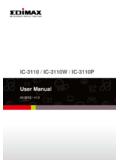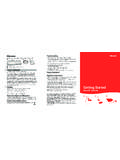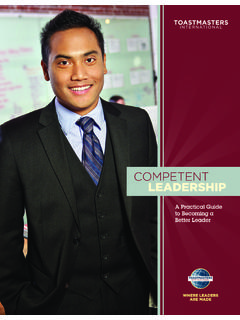Transcription of Intellectual Property Protection and Enforcement Manual
1 Intellectual Property Protection and Enforcement Manual : A Practical and Legal Guide for Protecting Your Intellectual Property RightsKPMG International s Trademarks are the sole Property of KPMG International and their use here does not imply auditing by or endorsement of KPMG International or any of its member firms. Table of ContentsIntroduction ..2 Case Studies ..23 ABRO Industries Inc ..23 Altria Group ..25 Bendix Commercial Vehicle Systems LLC ..27 Epson America, Inc ..29 Johnson & Johnson & Co ., Inc ..31 Merck & Co ., Inc ..33 Microsoft ..35 National Basketball Association ..37 NBC Universal ..39 New Balance ..41 Purdue Pharma LP ..43 True Religion Brand Jeans ..45 Unilever ..47 Xerox Corporation ..49 Appendix: Online Resources ..51 About Us ..52 Page 2 This Manual is intended to provide business owners with strategies for fighting the global problem of counterfeiting and piracy.
2 Business owners should find this Manual useful in gaining a better understanding of their Intellectual Property (IP) assets and to develop business practices and procedures that will help protect such assets from falling victim to counterfeiting and piracy. This Manual focuses on ways in which Intellectual Property brand owners can take the initiative in the fight against counterfeiting and piracy, but we recognize that this is only part of the solution. To effectively combat Intellectual Property theft brand owners must also vigorously cooperate with government Enforcement agencies (at the local, state, federal, and international levels). In addition, brand owners must seek and acquire the support of strategic partners and intermediaries throughout the supply chain all members of the legitimate business community who are wittingly or unwittingly facilitating the trade in illicit goods.
3 The Chamber of Commerce is actively involved in these dual efforts to increase the capacity of the law Enforcement agencies to enforce Intellectual Property rights, while engaging strategic partners in the fight against counterfeiting and piracy. To learn more about these efforts visit our website The Manual is divided into two sections. The first provides basic background information on Intellectual Property , specifically copyrights and trademarks, and the laws and regulations that can help businesses protect and enforce their Intellectual Property assets. The second section provides suggested practices that businesses can utilize as part of their overall anti-counterfeiting and piracy ProblemGlobal Intellectual Property theft and commerce in counterfeit and pirated goods are growing at an alarming pace. Counterfeiting is no longer limited to the knockoffs of high-end designer handbags sold on city street corners but, instead, has evolved into a sophisticated black market industry involving the manufacture and sale of counterfeit versions of an unimaginable number of products.
4 Reports of counterfeit pharmaceuticals, infant formula, automobile parts, batteries, and electronic products occur all too frequently and make chillingly clear the potential harm that could be inflicted on consumers, not to mention the counterfeited brand. At bottom, counterfeiters are opportunists Page 3 Brand Protection Manualmotivated by greed and will move whatever products they can through their illicit chains of distribution. Indeed, whether it is knockoff designer handbags or fake pharmaceuticals, it does not matter to the counterfeiters as long as there is a market for the product, they will manufacture and sell it. Accordingly, every business is at is estimated that Intellectual Property theft costs domestic companies between $200 billion and $250 billion a year1 in lost revenues and has resulted in the loss of 750,000 jobs in the United The harm caused by counterfeiting and piracy cannot be overstated.
5 Every sale made by a counterfeiter is a sale that a legitimate business will never make. Because the counterfeiter is unlikely to have access to the same quality raw goods as the legitimate manufacturer and has no incentive to institute quality control practices or procedures, the resulting counterfeit product is most assuredly inferior in quality and, in many instances, can be downright dangerous compared to the legitimate product. As a result, an introduction into the market of a single counterfeit product has the potential to undermine and irrevocably damage years of building a business goodwill and determine whether your business has a counterfeiting problem, you should ask the following questions:Do you have well-known or emerging brands? Have your brands captured a significant share of the market? Do you have a unique product that would be desired at a low price?
6 Are you experiencing an unexplained increase in returns or consumer complaints? Are the reasons given for increased returns and complaints different than usual? Have you lost market share in a particular region or regions? If you answered yes to any or all of these questions, then someone, somewhere, is probably counterfeiting your product. If you are not sure, or need to better understand the scope of your potential problem, you should (1) analyze your returns, complaints, and market share trends for anomalies; (2) interview key members of your sales, marketing, and quality assurance teams to obtain their firsthand impressions of the problems; (3) perform market surveillance or covert buys in areas that have suspicious decreases in market share or increases in customer dissatisfaction; (4) survey the Internet for sales of your product at suspiciously low prices and from unauthorized sources.
7 And (5) investigate markets that you have not yet entered, because if your brand name has market share where you are not even doing business, it is pretty clear that you have a short, any company with a well-known, valuable brand should assume that its brand is already being counterfeited. For companies lucky enough not to be victims, it is a question of when, not if. Accordingly, all businesses should develop and implement anti-counterfeiting and piracy strategies and build them into their everyday business practices. It should be made clear from the CEO level to Page 4the factory floor that the business has adopted a zero tolerance policy toward counterfeits, and that every employee should be engaged in the fight to protect the integrity and goodwill of the brand. Your Intellectual PropertyTo best protect your Intellectual Property assets, it is essential to understand the various pieces that make up your IP portfolio.
8 Generally, a company s IP consists of trademarks, copyrights, patents, and trade secrets owned or used by the company in its business. With respect to brand Protection , the critical Intellectual Property assets, that is, those that go to how consumers recognize a company and its products, are trademarks and copyrights. While discussions of these various forms of IP can and do fill multivolume legal treatises, a thumbnail discussion of each is provided in this Manual . TrademarksTrademarks generally consist of a word, phrase, symbol, or design, or a combination thereof, that identify and distinguish the source of the goods of one party from the goods of another. A service mark is accorded the same legal status as a trademark under law, except that a service mark identifies and distinguishes the source of a service rather than a it is recommended, registration of a trademark is not required for a business to have rights in the mark.
9 Adoption and use in commerce by a business is sufficient to give rise to common law rights in the mark. Protection for trademarks exists within common law for as long as the mark is properly used. However, greater Protection exists for federally registered trademarks, such as the ability for Enforcement at Trademark law also protects trade dress, the design and appearance of a product together with all the elements making up the overall image, which serves to identify the product presented to the consumer. Trademark law, however, only protects trade dress that is nonfunctional and either inherently distinctive or has acquired secondary meaning, that is, has come to be recognized by the consuming public as an indicator of source. The elements of trade dress must be capable of being identified with particularity so that the public and competitors will know the exact there are no mandatory notice requirements for trademarks, owners of common law trademarks may use the symbol to provide notice of their claimed rights, while owners of registered marks may use the symbol or the designation Reg.
10 Pat. & Tm. Owning a trademark registered on the Principal Register in the Patent and Trademark Office (the Trademark Office) provides several advantages, including (1) constructive notice to the public of the registrant s claim of ownership of the mark; (2) a legal presumption of the registrant s ownership Page 5 Brand Protection Manualof the mark and exclusive right to use the mark nationwide on or in connection with the goods or services listed in the registration; (3) the ability to bring an action concerning the mark in federal court; (4) the use of the registration as a basis to obtain registration in foreign countries; and (5) the ability to record the registration with Customs and Border Protection (CBP) to aid in the seizure of infringing or counterfeit foreign Protection for a registered mark exists as long as the mark is properly used and its registration is maintained and renewed.







